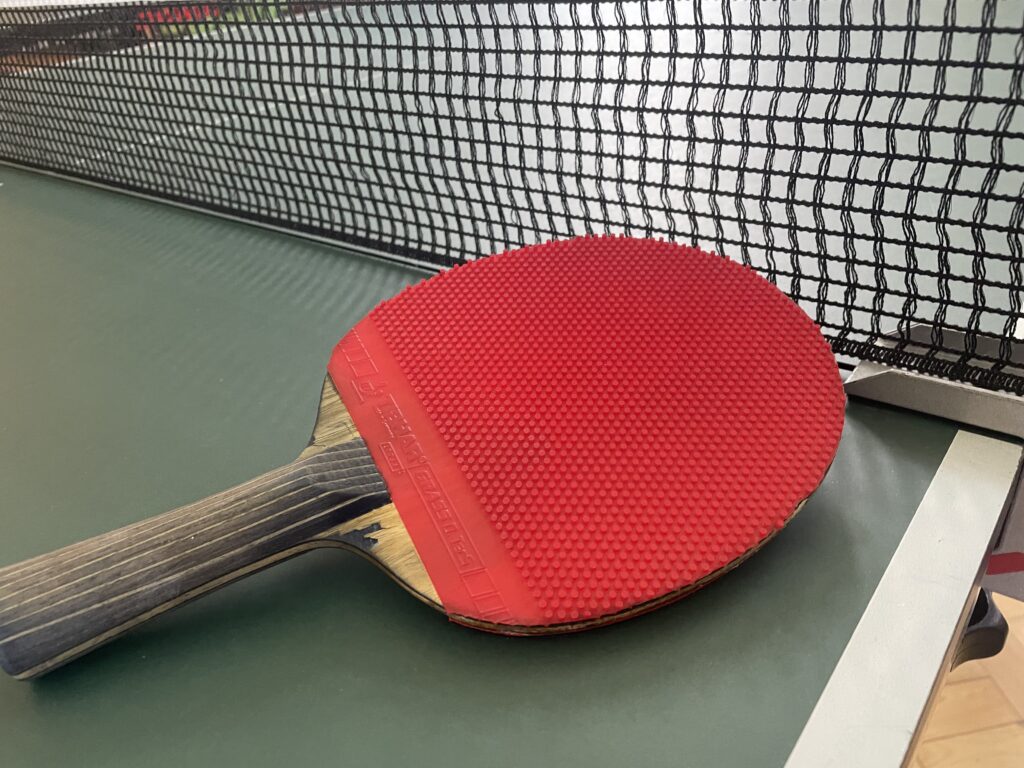
Table tennis is an unusual game as it allows players to use completely different equipment when playing. Even though inverted pimples is the main style of play, occasionally, we come across a player that uses a pimples-out rubber. These players often cause problems – especially to beginner/intermediate players that maybe haven’t had much exposure to these types of rubbers yet. This leads to many people wanting to know how to play against pimples. In this post I aim to outline some good habits to get into when playing pimple-out players and therefore increase your chance of beating them.
Don’t Play Them Blind
The first step to beating pimple players is to understand them. We have a separate post which looks into what each type of rubber is capable of; what their strengths and weaknesses are and what type of game style each type of rubber is suited to. All of this information is key to understanding and therefore gaining an advantage over your opponent. For example: if your opponent is using short pimples on their backhand we should instantly think that they want to counter our attacks that we put to their backhand. We can also assume that they are going to want to stay close to the table during rallies and a lot of shots are going to come back to us with little to no spin but with a lot of pace.
Before I have even started the match I have been able to understand how they are going to play against me. However, this isn’t possible without the prior knowledge and understanding of what the different types of rubber do. It also isn’t possible if you do not know what type of rubber they use. All of this prior knowledge is useless if you are guessing what their equipment is. Again, I get a lot of questions asking “well how do I know what type of pimples they have?” and there is a really simple and quick answer to this… you ask them.
I have never met a person that will ignore or refuse to answer this question. Also, if you ever run into the situation where someone does refuse to answer (which is very unlikely) they will have to show you their bat eventually. According to the official ITTF rules section 2.4.8: Before the start of a match and whenever he or she changes his or her racket during a match a player shall show his or her opponent and the umpire the racket he or she is about to use and shall allow them to examine it. This means that before the match starts you are entitled to examine your opponents bat so you will know what type of rubber they are using.
Every Pimple Player Is Different
Inverted pimple rubbers all – roughly – have the same strengths and weaknesses but individual players also have their own as well. Just like how you would analyse a player if they had inverted pimpled rubbers you should do the same for pimple-out rubbers. Each player you face with this equipment will have different weaknesses. For example one short pimple player may block and control really well but their counter hitting is not as consistent. When playing this opponent you may want to aim to play slower as you’re not as afraid of the counter hit as you are of being caught out of position. Alternatively, if the short pimple player had a dangerous counter hit but their blocking was a bit loose then, in this case, you may want to play more aggressively into the crossover point or wider angles. This is to try force them to block and not allow the counter hit.
Don’t just think that it’s a one size fits all situation. This will lead to you getting caught out and playing the wrong shots against the wrong opponents.
Short Pimples
Before we go through what tactics to specifically use on short pimples it is important top understand why these work so make sure you understand the differences in the types of rubbers. Short pimples struggle to generate spin and they prefer to flat hit through a ball negating all of that spin. This means that the ball is not going to react off of your bat as much when playing a short pimple player, so don’t close your bat over the ball when top spinning. You will want a more open bat face to account for the lack of spin. You can also think of this as lifting the ball a little – like you would for a backspin ball – with much less emphasis of going against spin.
This is the same for all aspects of playing against short pimple shots. They will have considerably less spin compared with that of an inverted pimple rubber. It is something to keep in mind when returning serves or pushes, not just attacking shots.
Another tactic to keep the ball as low to the net as possible. While short pimples are good at hitting through spin, since they negate most of the spin there is never enough topspin to drag the ball back onto the table after they have lifted the ball. This makes hitting through low shots very difficult. Especially backspin. Long, heavy, low, backspin pushes can really cause problems against this rubber.
Long Pimples
Just like in the previous section make sure you understand how long pimples work so you can understand how these tactics are effective. Long pimples really struggle to generate any spin of their own, more so than short pimples. However, they are extremely good at reversing spin. They can even add to the reversal and send more of your own spin back to you. This means that putting no spin to an opponents long pimple rubber can make for a really predictable return. The ball will have to return to you with little to no spin which can mean a much easier ball to attack. This means that if you keep playing no spin you will eventually receive a weaker ball that is relatively easy to attack and win the point.
Long pimple players are often aware that this is a weakness of their equipment and will work on keeping these no spin balls low and awkward to attack. In that case another strategy to use is to first topspin the ball into the long pimples and then when the ball comes back with backspin to push that ball. The next time the ball comes back it should have topspin on it so you can repeat the process. This prevents the long pimple player from adding more and more reversal making it more difficult for you to attack. Long pimples often rely on you making a mistake. Due to this it can be often a good idea to slow down, making sure that your shots are more consistent while still keeping the quality on your shots.
When using this strategy be aware that some long pimple players now are developing an attack by either using their long pimples or more commonly by twiddling their bat to use a different rubber.
Variation
As always, if you keep doing the same thing in a match your opponent will get used to it, they will be expecting it and they may be able to turn your own tactic against you. This is why you should add some variation into your play. If you always spin one then push one against a long pimple player maybe spin two every now and again just to keep your opponent on their toes. Similarly, if you have seen that no spin serves work very well against a long pimple player then you should still use heavy spin serves once in a while.
This will do two things, the first is stop you from being predictable and allow your opponent to captialise on your play. The second thing is that it will mean when you do use your winning tactic it becomes more effective as they are not able to keep playing the same way all the time themselves. They will have to adapt. This adaptation will draw out more errors and inconsistencies that you can take advantage of.
Conclusion
While there are tactics that you can use to play against pimple players there is not a single way to beat every pimple player out there. Each one has their own game style and their own strength and weaknesses. So, try different things, you can see what works for you and the opponent your playing. Finally, nothing will be better at teaching you how to play against pimples than playing against pimples. Spend some time practicing with a partner who uses pimples so that you can get to grips with how the ball is effected in real time. You can also try out lots of different strategies including the ones stated above without there being any pressure of a match.



I have never thought of asking my opponents about their types of pimples. But I will start doing that like you advised. I think it is good to understand your opponent, their bat and their style of play. I have always capitalised on my strength on studying the player. But understanding their tools will be a step further.
Understanding your opponents equipment is the first step in being able to predict what your opponent wants to do in the match. This allows you to build a game plan before you have even stepped up to the table. If your strength is studying your opponent this will definitely support you with that!
Hi, thank you for sharing insights on how to play against pimples in table tennis. It’s a challenging aspect of the game that many players face. I’m curious to know if you have any specific practice drills or strategies that you find particularly effective when preparing to face opponents who use pimples on their paddles? Any advice on developing a game plan to counter their style of play would be greatly appreciated.
Hi, it depends on the type of pimples you particularly struggle with. For example if you struggle with playing against long pimples I would try a serving drill. This would be a long, fast and flat serve into the pimples looking to open up with a strong attack on the third ball. Also for long pimples you could try an extended rally of trying to topspin a ball then push the following one. This is a standard routine used against long pimple players.
The best advice is to practice with someone who uses those rubbers to gain a feel for how they want to play and how the ball reacts to their equipment.